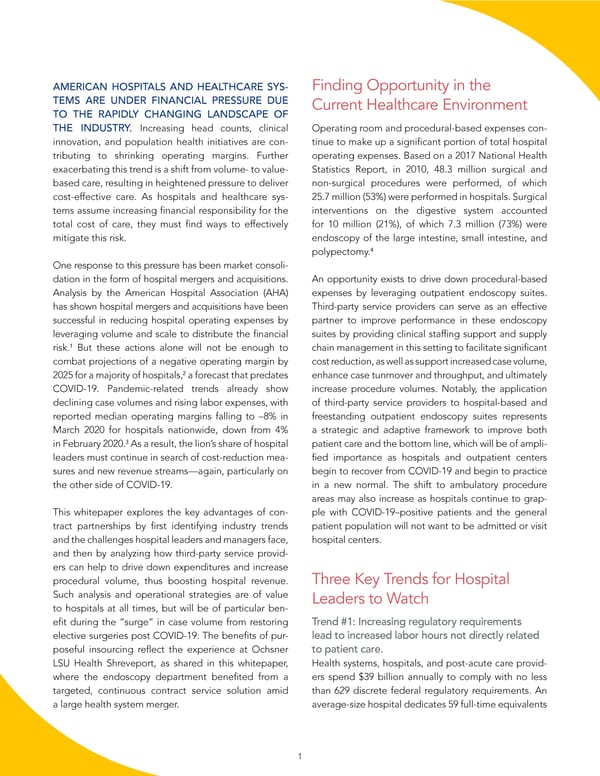AMERICAN HOSPITALS AND HEALTHCARE SYS- Finding Opportunity in the TEMS ARE UNDER FINANCIAL PRESSURE DUE Current Healthcare Environment TO THE RAPIDLY CHANGING LANDSCAPE OF THE INDUSTRY. Increasing head counts, clinical Operating room and procedural-based expenses con- innovation, and population health initiatives are con- tinue to make up a significant portion of total hospital tributing to shrinking operating margins. Further operating expenses. Based on a 2017 National Health exacerbating this trend is a shift from volume- to value- Statistics Report, in 2010, 48.3 million surgical and based care, resulting in heightened pressure to deliver non-surgical procedures were performed, of which cost-effective care. As hospitals and healthcare sys- 25.7 million (53%) were performed in hospitals. Surgical tems assume increasing financial responsibility for the interventions on the digestive system accounted total cost of care, they must find ways to effectively for 10 million (21%), of which 7.3 million (73%) were mitigate this risk. endoscopy of the large intestine, small intestine, and polypectomy.4 One response to this pressure has been market consoli- dation in the form of hospital mergers and acquisitions. An opportunity exists to drive down procedural-based Analysis by the American Hospital Association (AHA) expenses by leveraging outpatient endoscopy suites. has shown hospital mergers and acquisitions have been Third-party service providers can serve as an effective successful in reducing hospital operating expenses by partner to improve performance in these endoscopy leveraging volume and scale to distribute the financial suites by providing clinical staffing support and supply 1 risk. But these actions alone will not be enough to chain management in this setting to facilitate significant combat projections of a negative operating margin by cost reduction, as well as support increased case volume, 2 2025 for a majority of hospitals, a forecast that predates enhance case tunrnover and throughput, and ultimately COVID-19. Pandemic-related trends already show increase procedure volumes. Notably, the application declining case volumes and rising labor expenses, with of third-party service providers to hospital-based and reported median operating margins falling to –8% in freestanding outpatient endoscopy suites represents March 2020 for hospitals nationwide, down from 4% a strategic and adaptive framework to improve both 3 in February 2020. As a result, the lion’s share of hospital patient care and the bottom line, which will be of ampli- leaders must continue in search of cost-reduction mea- fied importance as hospitals and outpatient centers sures and new revenue streams—again, particularly on begin to recover from COVID-19 and begin to practice the other side of COVID-19. in a new normal. The shift to ambulatory procedure areas may also increase as hospitals continue to grap- This whitepaper explores the key advantages of con- ple with COVID-19–positive patients and the general tract partnerships by first identifying industry trends patient population will not want to be admitted or visit and the challenges hospital leaders and managers face, hospital centers. and then by analyzing how third-party service provid- ers can help to drive down expenditures and increase procedural volume, thus boosting hospital revenue. Three Key Trends for Hospital Such analysis and operational strategies are of value Leaders to Watch to hospitals at all times, but will be of particular ben- efit during the “surge” in case volume from restoring Trend #1: Increasing regulatory requirements elective surgeries post COVID-19. The benefits of pur- lead to increased labor hours not directly related poseful insourcing reflect the experience at Ochsner to patient care. LSU Health Shreveport, as shared in this whitepaper, Health systems, hospitals, and post-acute care provid- where the endoscopy department benefited from a ers spend $39 billion annually to comply with no less targeted, continuous contract service solution amid than 629 discrete federal regulatory requirements. An a large health system merger. average-size hospital dedicates 59 full-time equivalents 1
 Driving Efficiency & Throughput Page 1 Page 3
Driving Efficiency & Throughput Page 1 Page 3